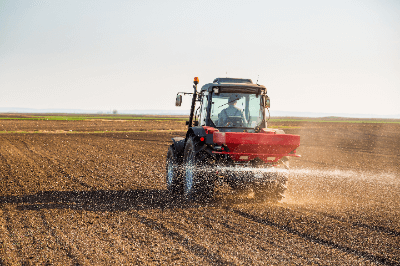What Is a Fertilizer Spreader?

A fertilizer spreader is a machine utilized to distribute fertilizers or compost.
Various shapes of fertilizers, including powder, granules, and liquids, can be accommodated. In the past, fertilizers and compost were manually spread, but with the introduction of fertilizer spreaders, the process has become highly efficient.
Moreover, the advent of fertilizer spreaders has enabled precise fertilization tailored to the growth of crops, allowing the application of the right amount at the right time. Consequently, it is considered one of the machines that significantly contributed to the advancement of agricultural technology.
Uses of Fertilizer Spreader
Fertilizer spreaders are chosen and used during the pre-planting and post-harvest periods in the fields. The usage period does not differ from other agricultural equipment. While they can also be used during planting, it requires ensuring that there is enough space for the tractor to maneuver or sacrificing some of the crops in the path of the tractor.
Primarily used to efficiently fertilize fields, larger spreaders increase efficiency. The use of a tractor reduces physical strain even with large amounts of fertilizer. Tractors with cabins also allow for avoiding dirt, making them indispensable equipment in modern agriculture.
Features of Fertilizer Spreader
Advantages
The advantages of fertilizer spreaders lie in their ability to efficiently distribute fertilizers and compost. The use of fertilizer spreaders reduces the burden on farmers. Additionally, one of the strengths is the ability to fertilize crops according to their growth.
Disadvantages
One disadvantage of fertilizer spreaders is that they need to maintain a uniform flow of fertilizer to be effective. To fertilize fields with moist compost or dry chemical fertilizers, it is essential to spread them uniformly. Achieving quality fertilization involves adjusting the flow of fertilizer through valves and controlling the force of fertilizer dispersion, making it challenging for beginners. However, modern versions have added electronic control functions for flow adjustment, enabling fertilization even without advanced skills.
Types of Fertilizer Spreader
Fertilizer spreaders are primarily classified into “towed” types, which use the power generated when the tractor is running, and “mounted” types, which are attached to the tractor to utilize its power. While these are the main categories, further divisions are made based on the shape and purpose of the materials to be spread.
1. Manure Spreader
The manure spreader is mainly used for spreading compost. It has a container-type fertilizer tank with a conveyor belt at the bottom. During spreading, the conveyor belt moves, dispersing the compost to the rear. The rotating blades scatter the approaching compost to the surroundings.
They come in various sizes, ranging from small ones with a capacity of less than 1 ton to large ones with a capacity of 5 tons, providing a wide range of sizes. When used in paddy fields, it is essential to consider the need for significant towing force and the possibility of getting stuck with wheels. However, in dry fields, it efficiently allows the spreading of a large amount of compost at once.
Manure spreaders come in both self-propelled versions with an independent power source and crawlers attached, making them suitable for use in paddy fields. The advantage of crawlers is that they can be used even on soft fields. However, specialized transport vehicles such as trailers are required for movement.
2. Broadcaster
The broadcaster has a cylindrical fertilizer tank, and a pendulum-like device swings left and right to spread the fertilizer. In addition to pendulum types, there are also types with rotating discs that scatter the fertilizer by rotating. One or two discs can be attached.
In larger sizes, some exceed 1 ton, requiring large tractors or the installation of counterweights.
3. Lime Sower
The lime sower, commonly attached to the rear of a tractor, also has a type that can be attached to the front. It is mainly used when spreading powdered fertilizers. Due to its ability to spread in a linear pattern close to the ground, it is advantageous for certain applications.
However, compared to the previous two types, its fertilization range is narrower, resulting in relatively lower efficiency.
4. Slurry Spreader
The slurry spreader is used primarily for spreading liquid manure from livestock. It can suck up from a manure reservoir into a tank and directly spread on the field.
The slurry spreader is like a machine with a vacuum truck mechanism, allowing it to spread liquid or semi-solid manure easily.